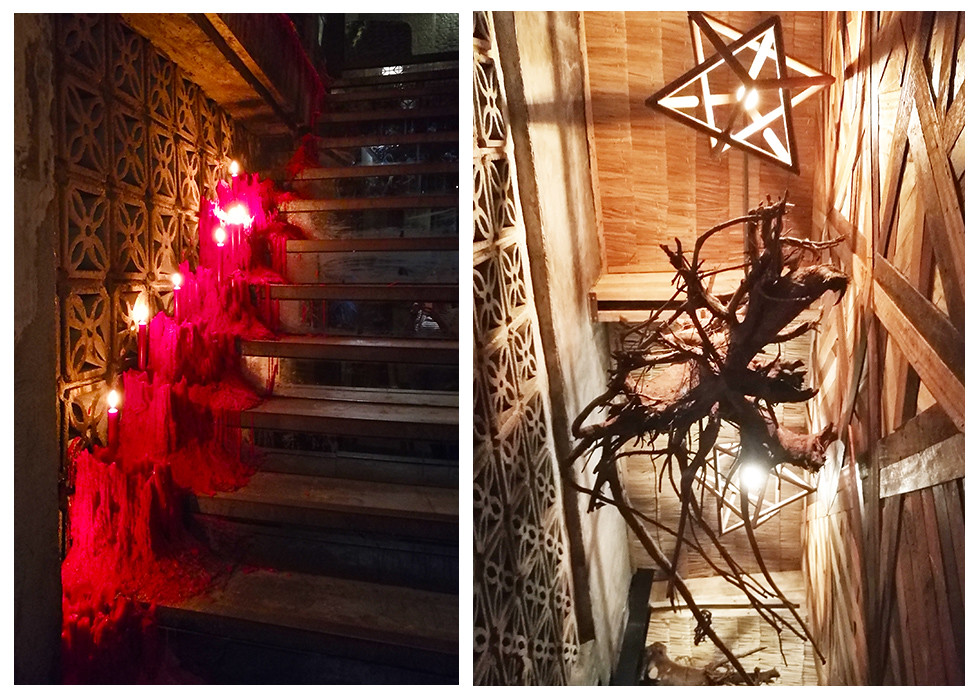I was in Manila to trek Taal Volcano but I made sure I have extra days to go on a food trip around Makati.
First stop is Agimat Foraging & Bar. I met the brains behind this concept: Chef Nino Laus and Mixologist genius Kalel Demetrio to check out the place.
Agimat Foraging & Bar is housed on the second floor of this rustic balay na bato along the corner of Alonso and Fermina Streets in Poblacion. Its name was derived from the Filipino folklore amulet called agimat or anting-anting which is known to possess magic powers when acquired.
Bewitching Bar
The entrance itself is already an experience. I was greeted with a staircase leading up the second floor lined with melting red candles that remind of a mangkukulam‘s (witch) secret lair. When I looked up, I found random driftwood as chandeliers.
The entire space was a feast for the creative eye, especially for a first-time visitor like me. Your eyes will be drawn towards the bar, which was designed with a balete tree showing off its gnarly roots smacked in the middle of the wall. Urban legend has it that balete tree houses spirits, dwarves and kapre (tree demon).
The shelves were lined up with jars and containers in all sizes, akin to a modern-day albularyo’s apothecary. Kalel pointed to the jars and shared that they also ferment their own liquor using fruits, vegetables, and other food items. They live up to their theme–Filipino cocktails and pulutan cuisine using local ingredients. They would forage in far-flung places and change their menu every three months to highlight a province.
Zero-Waste Heroes
Agimat Foraging & Bar is also a proud zero-waste advocate. Kalel and Chef Nino would exchange excess food items so that it can be used for the bar or kitchen. Shavings and trimmings would be utilized to its full extent leaving nothing to waste.
One of the bartenders showed me their edible straw made out of nangka (jackfruit). He explained that they dried up the fruit then rolled it to form a straw.
Handcrafted Concoctions
They also offered me to try their refreshing drink Gayuma Ng Paraiso. It contains dalandan liquor, white rum, guyabano ginger shrub, lime, mint, and blue pea flower spritz.
To drink this, you pour the rum (inside the shell) into the purple liquid and it turns into a lovely shade of blue. The blue pea flower spritz is responsible for its magical color transformation.
Most of their clientele are friends from the F&B circle and young professionals that got off from work to hang out at the bar with their friends. One of the customers ordered Ritual Ng Agimat. I was intrigued by their ritual. One of the bartenders told me that they made one for me so I can enjoy the full experience.
Two masked guys are tasked to perform the Ritual Ng Agimat. First, one of them brought out a drum to start a beat. Then the second masked guy carried 2 silver tin mugs that were lit with blue fire. Then they start their own hypnotic chant while the two mugs made a dance by transferring the flaming blue liquid from one mug to another. They finished it off with a unison “huh!” from the bartenders and the masked guys. Very theatrical and Instagrammable! Any barista wants to highlight one product for its brand to be remembered. In this case, they brought out Ritual Ng Agimat to tease the human senses. Check out the video below how they presented the drink.
On my second visit, we had Balaraw Ng Apoy – made of dark rum, white rum, seven-year rum, hibiscus, passion fruit, local lemon, and toasted peanuts. It was a flaming drink that teases your sense of sight and taste.
All the servers wore black-issued vests with handwritten baybayin letters with bandanas around their heads a la Katipunero-style.
Pulutan
I was not able to try all the food on the menu but I loved the Burong Maliputo (fermented freshwater trevally). It is served on top of black-colored sago chips, alugbati, buro, and dulong served on a wooden plate.
Kalel mentioned that the Maliputo fish is endemic to Batangas and found in Taal Lake. Since it is endemic, they ferment the fish to control the stock they got and so that they can serve it at the restaurant over a long period of time.
If ever you find yourself in Poblacion, Makati, you should do a restaurant tour. They have amazing concepts and underground restaurants for you to choose from.

















